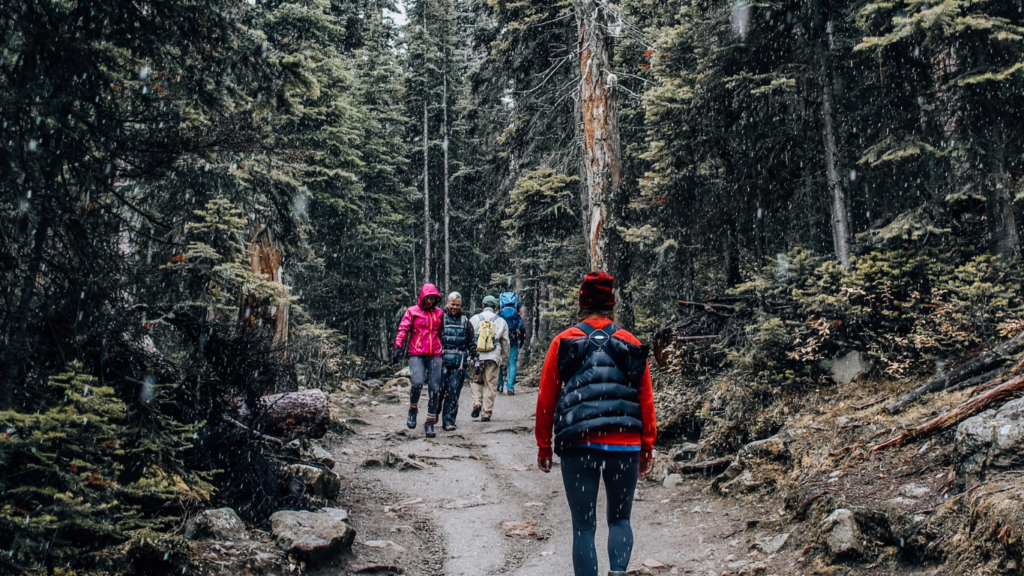Benefits of Long-Distance Hiking
Long-distance hiking offers numerous physical health benefits. Hiking strengthens muscles, improves cardiovascular health, and enhances endurance. Engaging in this physical activity increases cardiovascular fitness, boosts muscle strength, and enhances bone density due to its weight-bearing nature.
Mental health benefits are also significant. Hiking promotes mental clarity and reduces stress. The natural environment and physical exertion can alleviate symptoms of anxiety and depression. Researchers from Stanford found that walking in nature reduces ruminative thoughts and increases overall mood.
Being immersed in nature leads to a unique connection with the outdoors. Long-distance trails often pass through diverse ecosystems, allowing hikers to experience various landscapes. This deepens appreciation for natural beauty and fosters a greater sense of environmental stewardship.
Personal growth and resilience develop through these challenging hikes. Each trail requires planning, resourcefulness, and perseverance. Overcoming obstacles, like tough terrain or inclement weather, builds resilience and self-reliance.
Long-distance hiking also encourages social bonding. Meeting fellow hikers on the trail creates a sense of camaraderie. Sharing experiences and stories around a campfire forges strong friendships and a supportive community.
Long hikes often serve as a digital detox. Disconnecting from technology helps hikers reconnect with themselves and their surroundings. This break from screens and constant notifications rejuvenates the mind and spirit.
Hiking can be an educational journey. Learning about the flora and fauna along the trails expands knowledge and fosters a deeper understanding of the environment. Interpretive trails and markers provide historical and cultural insights.
The benefits of long-distance hiking extend far beyond physical fitness. These trails offer mental health improvements, personal growth, social connections, and educational experiences. Each step taken on these paths leads to a richer, more fulfilling life.
Top Long-Distance Hiking Trails in North America

North America offers some of the best long-distance hiking trails, each with unique challenges and stunning landscapes. Here are three of the top trails.
Appalachian Trail
The Appalachian Trail spans about 2,200 miles. It traverses 14 states from Georgia to Maine. This trail challenges hikers with its varied terrain and unpredictable weather. Popular stops include the Great Smoky Mountains National Park, Shenandoah National Park, and the White Mountains in New Hampshire. Most hikers complete the trail in 5-7 months. The Appalachian Trail Conservancy provides resources and updates on trail conditions.
Pacific Crest Trail
The Pacific Crest Trail (PCT) extends for approximately 2,650 miles. It runs from Mexico to Canada through California, Oregon, and Washington. This trail passes through diverse ecosystems like deserts, forests, and alpine regions. Notable sections include the John Muir Trail in the Sierra Nevada, the Cascade Range, and Crater Lake National Park. Many hikers aim to complete the PCT in one season, typically taking 5-6 months. The Pacific Crest Trail Association offers planning tips and permits information.
Continental Divide Trail
Covering around 3,100 miles, the Continental Divide Trail (CDT) stretches from Mexico to Canada, roughly following the Continental Divide. This rigorous trail features remote wilderness, challenging navigation, and extreme weather conditions. Major highlights include the Rocky Mountains, Glacier National Park, and the Gila Wilderness. Thru-hikers generally finish the CDT in 5-6 months. The Continental Divide Trail Coalition supports hikers with maps, trail updates, and permitting advice.
Best Long-Distance Hiking Trails in Europe
Europe offers some of the most scenic and historically rich long-distance hiking trails. Here are three of the best routes that attract hikers from around the world.
Camino De Santiago
The Camino de Santiago, also known as the Way of St. James, is a network of ancient pilgrim routes leading to the shrine of the apostle Saint James in Santiago de Compostela, Spain. Spanning approximately 500 miles, the Camino’s most popular route, the Camino Francés, crosses northern Spain from the Pyrenees to Galicia. Hikers can traverse quaint villages, lush forests, rolling hills, and significant cultural landmarks. Most people complete the trail in 30-35 days, enjoying not only the natural beauty but also the rich history and camaraderie of fellow pilgrims.
Tour Du Mont Blanc
The Tour du Mont Blanc (TMB) is a stunning 110-mile trek around the Mont Blanc massif, passing through France, Italy, and Switzerland. This trail offers some of the most spectacular alpine scenery, including glacier views, towering peaks, and lush valleys. Typically completed in 10-12 days, the TMB challenges hikers with its diverse terrains, ranging from easy paths to steep ascents. The route provides opportunities to experience various cultures, cuisines, and accommodations along the way, making it a favorite among alpine hikers.
West Highland Way
Scotland’s West Highland Way stretches 96 miles from Milngavie, near Glasgow, to Fort William in the Scottish Highlands. This route features a mix of picturesque lochs, rolling hills, and rugged highlands. The trail takes most hikers about 7-9 days to complete, offering a combination of well-marked paths and challenging terrains. Along the way, hikers can explore historic sites, quaint villages, and the beautiful Loch Lomond. The West Highland Way is known for its diverse landscapes and the warm hospitality of the people along the route.
Long-Distance Hiking Trails in Asia
Asia offers some of the world’s most extraordinary long-distance hiking trails. Its diverse landscapes, cultural richness, and challenging terrains have drawn hikers from across the globe.
Great Himalaya Trail
The Great Himalaya Trail spans approximately 1,700 miles across Nepal. It traverses the entire length of the country, linking popular regions like Everest, Annapurna, and Kanchenjunga. Trail segments vary from high-altitude passes at over 18,000 feet to lush, subtropical valleys. Hikers witness dramatic contrasts in ecosystems and cultures due to the trail’s extensive coverage. On this trail, climbers can explore remote villages, stunning mountain vistas, and UNESCO World Heritage sites. While the trek demands significant experience, preparation, and endurance, the trail promises unparalleled adventure and awe-inspiring natural beauty.
Shikoku Pilgrimage
The Shikoku Pilgrimage, or “Ohenro,” covers 750 miles on Japan’s Shikoku Island. The route connects 88 temples, following a loop across the island’s four provinces. Rooted in Buddhist tradition, the pilgrimage allows hikers to experience spiritual contemplation while exploring temples and scenic coastal paths. Modern infrastructure supports pilgrims with accommodations and wayfinding markers. Though shorter than the Himalaya Trail, the Shikoku Pilgrimage requires hikers to be in good physical condition due to its mixed terrains. Hikers encounter ancient temples, vibrant forests, and welcoming local communities. This trail offers both a physical challenge and opportunities for cultural enrichment and personal reflection.
Essential Gear for Long-Distance Hiking
Long-distance hiking requires careful gear selection to ensure safety and comfort. Attention to detail in choosing footwear, backpacks, and navigation tools can make or break the experience.
Footwear
Proper footwear is critical on long-distance hikes. Choose hiking boots or trail shoes with durability and support. Ensure they’re broken in before starting. Waterproof and breathable materials keep feet dry in varied conditions. Consider lightweight, quick-dry socks to reduce blisters. Examples include Merino wool socks and moisture-wicking synthetics.
Backpacks
A quality backpack distributes weight evenly, reducing strain. Choose one with padded straps and a hip belt for stability. Ensure it’s large enough (40-60 liters) to carry essentials without excess weight. Look for features like hydration reservoirs and multiple compartments. Brands like Osprey and Gregory offer reliable models suited for long hikes.
Navigation Tools
Reliable navigation tools prevent getting lost in unfamiliar terrain. Carry a map and compass as the primary tools; GPS devices and smartphone apps serve as backups. Ensure familiarity with orienteering and device operation before the hike. Examples of useful apps include AllTrails and Gaia GPS, which provide detailed trail maps and real-time location tracking.
Tips for Successfully Completing a Long-Distance Hike
Long-distance hikes offer numerous rewards but require thorough preparation. Leveraging the right strategies ensures completion and enjoyment.
Physical Preparation
Conditioning the body is paramount for long-distance hikes. Emphasize cardiovascular and strength training. Include activities like:
- running
- cycling,
- weightlifting to build endurance and muscle
Simulate hiking conditions by walking on varied terrains with a loaded backpack. Perform these exercises at least three months before the hike to acclimate the body to prolonged physical activity.
Mental Preparation
Mental resilience is just as critical.
- Set realistic goals and visualize completing each segment of the trail.
- Break the hike into manageable sections to avoid feeling overwhelmed.
- Practice mindfulness and stress-reduction techniques like meditation or deep breathing.
- Engage with others who have completed similar hikes to gain insight and boost confidence.




